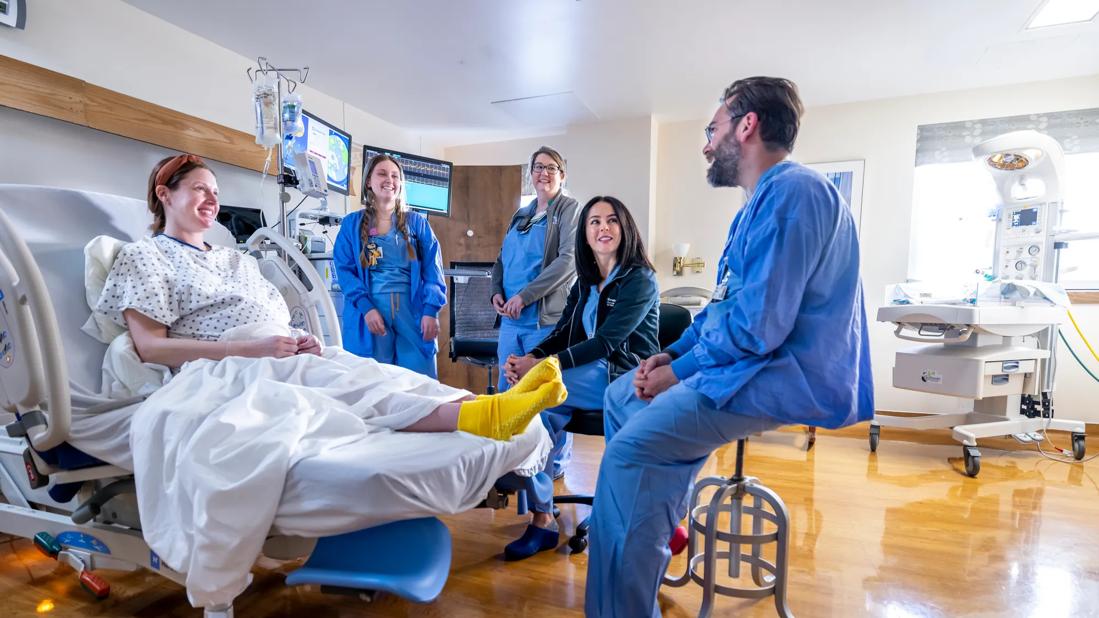Cleveland Clinic Children’s pioneers a collaborative approach

Collaborative medical rounds, implemented last spring, help reduce patient length of stay, readmissions and adverse events, and improve teamwork.
Advertisement
Cleveland Clinic is a non-profit academic medical center. Advertising on our site helps support our mission. We do not endorse non-Cleveland Clinic products or services. Policy
The plan of care visit, in which physicians and nurses make rounds together, was formally implemented at Cleveland Clinic Children’s in May 2019 after first being initiated in the adult population. “Actually, we have been doing informal plan of care visits at Cleveland Clinic Children’s for at least 12 years,” says Christine Traul, MD, Assistant Professor of Pediatrics, Pediatric Hospitalist and Patient Experience Officer at Cleveland Clinic Children’s. “We have routinely asked our bedside nurses to do morning rounds with us as we meet with parents and patients.”
The formalized plan of care visits ensure the bedside nurse, primary medical team physician/advanced care provider, patient and a parent or legal guardian are involved with and actively engaged for medical rounds.
A literature review of 25 studies with adult patients conducted by the Office of Patient Experience at Cleveland Clinic found that plan of care visits reduce hospital length of stay, readmission, mortality, adverse events and inpatient costs, while enhancing the patient experience. Patients report increases in shared decision-making, staff teamwork and communication of consistent information from doctors and nurses. For caregivers, plan of care visits improve teamwork, interprofessional communication and job satisfaction, and reduce inefficiency (including calls to physicians) and burnout.
“When done well and consistently, plan of care visits — previously called family-centered rounds — result in much clearer communication among providers and with the family,” reports Janie Burke, MBA, BSN, RN, CPN, NE-BC, Clinical Nursing Director for Cleveland Clinic Children’s and Cleveland Clinic Children’s Hospital for Rehabilitation. “Given how dynamic the situation is in the hospital environment and how many professionals may be entering the room and giving families different information and opinions, the plan of care visit allows us to convey a unified message to the family.” No one is left out of the loop as everyone hears the same information. “This includes parents, who are part of the care team, and can help to support and achieve daily goals for their children,” she says. “For example, if the plan is to get the child to ingest more fluid, parents can encourage the child to drink during the day.”
Advertisement
Dr. Traul notes that the plan of care visit creates an added layer of information and interaction with parents, and allows nurses to reiterate goals to parents throughout the course of their shift.
Process steps for plan of care visits start with scheduling visits to the ward to ensure the bedside or charge nurse is ready to round with us, says Dr. Traul. “Residents, fellows, pharmacists and subspecialists may also be present or may participate via Skye or another video platform.”
Once in the patient’s room, residents present the case to the team, perform a clinical assessment and ask parents how things are going with their child. Providers are encouraged to ask questions (e.g., What matters most to you today and what do you want to make sure we cover?).
Nurses are encouraged to report overnight concerns or changes in condition. “Because nurses are with patients for hours each day, they may observe subtle changes that other providers might overlook,” says Burke. “For example, a nurse might think the patient is sleepier than he or she has been before and suggest that the team look into that. Because the nurse is included as a valued member of the team, he or she might be more confident about speaking up about little things like that, which actually might be important to the patient case.” Nurses are also called upon to report on medication use, status of lines/drains/airways, nutrition and other clinical/safety concerns.
With other members of the team, physicians create a plan of care, discuss active issues, recommended tests and consultations and length of stay/discharge plans. Either the provider or the nurse will be designated to record the plan of care visit in Epic.
Advertisement
Burke suggests that if other hospitals are looking to institute a plan of care visit program, “the starting point is to see the value in this kind of protocol. It’s easy to duck into a room, do your thing and leave because you have 20 other things to do. So you have to prioritize teamwork over your individual tasks because there are many barriers to implementation.” Dr. Traul adds that, “by empowering everyone in the room during the plan of care visit to be responsible for the patient’s care—the parents, nurses and physicians—we improve the child’s care. Everyone is on the same page and aware of plans for the patient that day and over the course of the hospital stay, so it’s less likely that things will go awry or goals will be changed by an unenlightened party. Everyone on the team feels appreciated and heard, and that their participation is valued.”
Advertisement
Advertisement

Mobility carts provide exercises and tools

Nurse researchers explore the relationship between readmission risk scores and acute care transfers

Guiding nurses amid a constantly evolving healthcare landscape

Ideation session generates solutions to medication administration errors

Caregivers spearhead changes that improve patient care, shape hospital culture

Building a culture that supports, engages and empowers nursing staff

Nurses harness cutting-edge technology as a bridge to healing

Dedicated leader shares her passion for quality, education and professional development